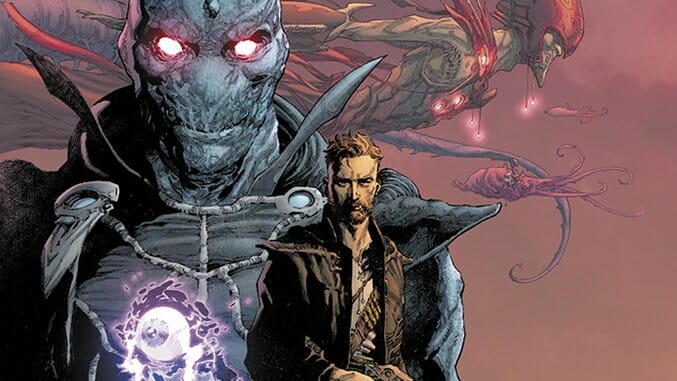Image Expo Exclusive: Rick Remender & Jerome Opeña Pit Men Against Gods in New Fantasy Comic Seven to Eternity

Moments ago in Seattle at Image Expo 2016, Rick Remender announced Seven to Eternity, a blisteringly ambitious take on the fantasy genre illustrated by Jerome Opeña and colored by Matt Hollingsworth. The project chronicles the adventures of a dying knight, Adam Osidis, who sets out to slay the insidious God of Whispers—a musical demon deity who manipulates humanity and conjures snake-wolf hybrids from the earth. Like the inhabitants of this new world, Zhal, we’re all ears.
The series marks the fifth original property Remender has recently erected at Image Comics, following the surreal sci-fi dystopias of Black Science, Low and Tokyo Ghost and the ‘80s grindhouse Bildungsroman in Deadly Class. Seven to Eternity is also an Image Comics reunion for Remender and Opeña, who worked together on the comic Strange Girl before collaborating on Fear Agent, Punisher, Uncanny X-Force and Avengers: Rage of Ultron.
Outside the red tape of established properties, Opeña and Remender are embracing the creative freedom of this infant fiction. Opeña cites the surreal escapism of Moebius (Metal Hurlant) as a key inspiration, while Remender is creating a unique take on the genre, filled with unconventional powers and a supernatural spiritual ecosystem. Matt Hollingsworth, whose colors have graced projects as diverse as Matt Fraction and David Aja’s urban epic Hawkeye to Scott Snyder and Jock’s feverish horror opus Wytches, lends shocking blues and sunrise gradients to Opeña’s chiseled line work.
Though we’ll have to wait till fall for the first issue, Paste discussed the new comic with Remender and Opeña, who were kind enough to share this exclusive preview featuring an electric blade-welding warrior and the most devastating flute solo you’ll encounter outside an office elevator.
![]()
Paste: Rick, you’ve been seeding a series of new sci-fi/fantasy worlds with Black Science, Low and Tokyo Ghost. What does Seven to Eternity allow you to explore that those other titles don’t?
Rick Remender: Well, none of those are strictly fantasy in the way Seven to Eternity is. Our story takes place in Zhal, a world where spirits inhabit all energy, and a gifted few can access those spirits. The laws of the world are based around this and offer us unlimited ways to create characters with strange and never-before-seen-powers based on this unique fuel source.
Paste: Seven to Eternity is described as a modern fantasy. How do you define fantasy? What attracted you to the genre as you see it?
Remender: There is no science in this world, simply those who can access the spirits within all energy and those who cannot. So I’m not locked down by the natural laws of our world; we’re creating a strange place with its own set of rules. This allows us to deeply develop the characters and their connection to Zhal. It’s modern simply in that it is a wholly new approach to this type of world, with few of the same tropes one comes to expect from fantasy. No dragons or wizards—new classifications, new power sets, new, new, new. “Marcia, Marcia, Marcia.”

Seven to Eternity #1 Interior Art by Jerome Opeña and Matt Hollingsworth
-

-

-

-

-

-

-

-

-

-

-

-

-

-

-

-

-

-

-

-

-

-

-

-

-

-

-

-

-

-

-

-

-

-

-

-

-

-

-

-












































